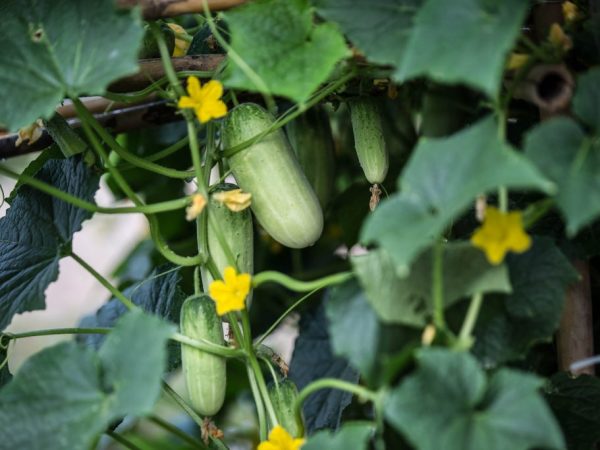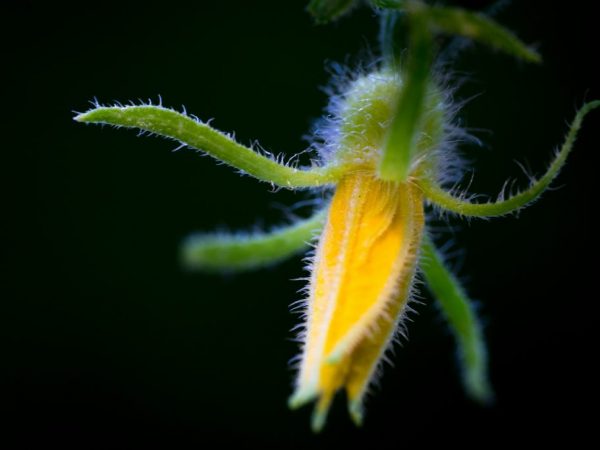The process of setting and growing cucumbers
Cucumbers are one of the most popular vegetable crops known for their demand for light, heat and nutrients. It doesn't matter how cucumbers grow - in greenhouses or outdoors. If you follow the standard rules of agricultural technology, you can get a rich harvest.

The process of setting and growing cucumbers
The main stages of growth and development
During the growing season, the plant forms new cells, tissues, organs, increasing its volume and mass. The growth and development of culture is carried out in stages and is accompanied by the formation of foliage, shoots, buds, ovaries and fruits.
Emergence of seedlings
Active absorption of moisture by the seed, its swelling and increase in volume.
In this phase, thanks to the vigorous activity of enzymes, the embryo receives organic nutrients and oxygen.
In cucumbers, in favorable conditions, germination occurs at a temperature of 12-16 ° (therefore, when planting in open ground, it is recommended to warm up the soil). In conditions of heat shortage, there is a risk of seed rot.
Growth process
The formation of cotyledon leaves and depletion of food reserves contained in the seed. The foliage receives carbon dioxide, the roots receive nutrients from the soil.
The germination time depends on the temperature: 4-6 days after sowing at 25-30 °, 6-10 days at 20-25 °, 8-12 days at 17-20 °.
For a full-fledged development at this stage, a culture needs a set of favorable conditions - a sufficient amount of light, heat, water and food. Lack of any of these items can lead to the death of the plant.
First, the development and strengthening of the root system occurs, then a rapid increase in the volume of green mass. In varieties of early ripeness, 4-6 leaves are formed, late-ripening 5-8 leaves. After their formation, lateral shoots begin to appear on the main stem.
Fertilization and ovary formation
Buds begin to form after slowing down the formation of leaves and roots. Flowering occurs in early ripeness varieties on the 30-40th day, in late-ripening varieties - on the 45-60th day at a temperature of 20-28 °. The first to bloom are the buds on the main stem, then from the bottom upwards along it, then moving on to the shoots of the first and subsequent orders.
Cucumber varieties are divided into:
- self-pollinated (having a pistil and a stamen in one flower);
- bee-pollinated;
- parthenocarpic (hybrids with only female flowers that do not require pollination).
Regardless of the grade, each flower has about 3-5 days for fertilization, after which the petals dry out.
The lower part of the pistil (fruit ovary) after fertilization quickly grows in length and width, forming a green cucumber. The optimum temperature for the development of ovaries is 22-28 °.
Growth and ripening of fruits

The duration of fruiting depends on the variety.
7-12 days after fertilization, the fruit of technical ripeness appears (green). Simultaneously with the growth process, seeds are formed in it and nutrients are accumulated.
The cycle from the stage of technical to physiological ripeness (complete ripening of cucumber seeds in the fruit) is determined by the growing conditions and the variety of the vegetable. On average, it is 30-45 days. Cucumber bears fruit for a long time, in accordance with the characteristics of a particular variety, it takes about 20-90 days from the first to the last harvest.
Common mistakes
Cucumbers require ample amounts of heat, light, air, nutrients and water. The lack of any of these components can seriously harm the crop and lead to reduced yields.
The reasons for the loss of yield are the following errors of agricultural technology:
- Failure to comply with the rules of crop rotation. The best precursors to cucumbers are cauliflower, onions, garlic, legumes, and corn. You should not plant cucumbers in the place of the previous sowing, as well as after white cabbage, tomatoes, carrots, turnips, peppers and eggplants.
- Sowing seeds in open ground in early May. When sowing, it is always necessary to focus only on the weather conditions; the soil must warm up for at least two weeks. Sowing in cold soil can lead to seed rot.
- Planting overgrown seedlings (over 20-35 days). The older the seedling, the worse it will take root in the new conditions and the easier it will be to damage its root system during transplantation.
- Too tight fit (thickening). Plants in such conditions experience a lack of light and air, which leads to their weakening and an increase in the chances of developing diseases.
- Refusal to apply fertilizers. The ideal feeding regime is one portion per week (you can use complex mineral fertilizers, paying special attention to the presence of nitrogen and potassium).
- Rare collection of fruits. The yield of the culture directly depends on the frequency of collection of greens, even a few overgrown fruits can delay the formation of new ovaries on the entire plant.
Ovary formation problems
For any varieties of cucumber, the formation of full-fledged ovaries ensures a good yield of high-quality fruits.
The formation of fruit ovaries can be influenced by various factors: climate, diseases, mistakes in agricultural technology. Tying disorders are classified into the following types:
- the formation of barren flowers (exclusively male flowers);
- deficiency of ovaries;
- their wilting.
Formation of barren flowers

The formation of barren flowers is influenced by several factors.
Bee-pollinated cucumbers have male and female inflorescences. Barren flower is a male (staminate) flower, in which pollination and fertilization does not occur, is formed on the plant in the first place. The reason for the absence of ovaries in such varieties is that there are no female (pistil) flowers necessary for fruiting.
The formation of barren flowers can be caused by the following factors:
- lack of area for the formation of a superficial root system (located at a depth of 15-20 cm from the surface) and the resulting deficiency of nutrients;
- lack of moisture;
- absence of pollinating insects;
- overabundance of dressings (fattening), in which female flowers do not form for a very long time.
Paucity of ovaries
Causes of deficiency of fruit ovaries:
- excess heat, especially relevant for greenhouse cucumbers (temperatures above 35 °);
- high air humidity;
- prolonged decrease in air temperature (leads to a decrease in the population of pollinating insects);
- deficiency of nutrients in the soil;
- delay in harvesting;
- drying of the ovaries.
The reasons for the wilting of flowers and formed ovaries:
- Neglecting the formation of plants, which allows you to redirect food from extra shoots to the development of fruit ovaries.
- Excessive thickening of the plantings and lack of nutrition.
- Deficiency of moisture in the soil (at the phase of setting and the formation of greens, the plant requires an increased level of irrigation).
- Planting bee-pollinated varieties in areas inaccessible to insects (greenhouse or greenhouse).
- Untimely collection of ripe fruits (the resulting ovaries dry out due to lack of nutrition).
Methods for eliminating problems with the ovary
Any deviations in the formation of ovaries and fruits can lead to a decrease in yield or even its complete absence.
Fight against growth disorders:
- regulation of the conditions in which the culture grows (most important in greenhouse conditions);
- cessation of watering for 2-3 days and the introduction of complex dressings (stimulates the formation of female flowers);
- fertilizing the soil with small portions of organic fertilizers and urea (eliminates the deficiency of nutrients);
- the introduction of foliar dressings with the addition of the preparations "Ovary", "Epin", "Kemira" or "Zircon";
- mulching the soil with sawdust, needles or dried grass (it helps to regulate the daily temperature of the soil, retain moisture in it and prevent weeds from germinating);
- collecting zelents (depending on the variety, the crop can be removed once every couple of days or even every day).
- preventive actions.
Prevention of tying disorders
To prevent problems in the formation of fruit ovaries, the following rules are most effective:
- Compliance with the optimal selection of varieties for planting in open or protected ground (self-pollinated, bee-pollinated or parthenocarpic hybrid).
- Installation of drip irrigation to increase the efficiency of the fertilization and irrigation regime. Drip irrigation is most advisable, because does not cause destruction of soil layers and reduces labor costs for loosening the soil.
- Carrying out soil preparation in compliance with the culture cultivation technology. The soil on which the cucumber grows should not be over-enriched with top dressing, or be deficient in them.
- Carrying out regular inspections of plants, carrying out preventive treatments to raise immunity and prevent infection of the crop with diseases or insect pests (foliar dressing and spraying of plants).
Conclusion
Cucumber is a thermophilic culture sensitive to moisture levels and timely collection of fruits. The combination of the methodical implementation of all points of care and preventive measures will ensure the formation of stable ovaries and a rich yield of high quality greens.


